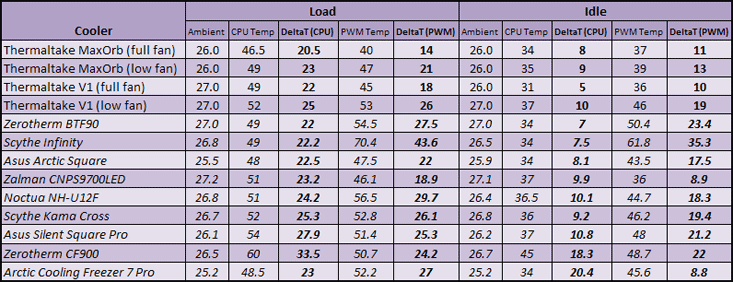
Results
The results are ordered according to the red temperature delta values, rather than just the lowest value recorded in blue.Both the Thermaltake MaxOrb and V1 on a high fan setting outperformed anything else we've reviewed to date with a super low 20.5ºC and 22ºC temperature difference between heatsink and surrounding air. However the crux is we'd never bear to leave the fans on that loud whilst being in the same room. Normally they'd be turned down to somewhere between mid way and low which would sit the cooling performance around that of the Asus Arctic Square and Zerotherm BTF90.
The popular Zalman CNPS9700 at full fan is very noisy, and still not as good as the Thermaltake MaxOrb at the lowest setting, and the MaxOrb is even a fraction cheaper than the Zalman as well.
The Scythe Infinity performs a fraction better than the MaxOrb running at low noise fan speeds, but it's such a sheer pain in the backside to install and remove in comparison. The Asus Arctic Square still performs slightly better but it's still more expensive again and we had a build quality issue with our model, although it does manage to be physically smaller for a similar performance.
Despite our concerns about the V1 fan not cooling the PWM heatsink because the fan is vertically mounted, the temperatures are actually comparable or less than other coolers at between 45 and 53ºC, depending on how fast the fan is spinning. At a mid way compromise between noise and cooling you're aiming at around 47-50ºC with a deltaT of ~20-22ºC, so you're on the better side of average.
Value
The V1 is slightly more expensive than the MaxOrb, but they are both still cheaper than the Zerotherm BTF90 and Asus Arctic Square and in the same league as the Scythe Infinity. They're both also cheaper than the Noctua and Zalman CNPS9700 but the 9500 model is about the same price as the MaxOrb. However, both the V1 and MaxOrb offer better cooling.Final Thoughts
Neither of these heatsinks are outright cheaper than the competition, but they are both available around the £30 mark - this is certainly a viable cost to anyone looking for a performance cooler. The MaxOrb is on the right side of that £30 depending where you shop and offers a marginally better performance, although it is physically larger. But does that matter? It still fits on every board we tried it on and even though the mounting is a bit of a hassle at first, once the clips are on/screws are in, it's job done in five minutes. Pop the kettle on and have a brew waiting for when you've finished.The V1 has more intuitive and accessible clips, whereas the Orb needs clips and a screw retention, but the beauty of the MaxOrb is that the retention clips don't need forcefully pushing into the motherboard because they are just used to mount the surrounding plate.
All in all, set the fan to medium-low and both will cool fantastically well for a very reasonable investment of around £30. Both provide a great cooler for the investment, but the MaxOrb simply looks great in a case and despite being a pain to install, once in, it performs better than the V1 with a similar amount of (low) noise.

Thermaltake V1
- Build Quality
- x
- x
- x
- x
- x
- x
- x
- x
- -
- -
- 8/10
- Ease of Use
- x
- x
- x
- x
- x
- x
- x
- x
- -
- -
- 8/10
- Performance
- x
- x
- x
- x
- x
- x
- x
- x
- -
- -
- 8/10
- Value
- x
- x
- x
- x
- x
- x
- x
- -
- -
- -
- 7/10
- Overall
- x
- x
- x
- x
- x
- x
- x
- x
- -
- -
- 8/10
Thermaltake MaxOrb
- Build Quality
- x
- x
- x
- x
- x
- x
- x
- x
- x
- -
- 9/10
- Ease of Use
- x
- x
- x
- x
- x
- x
- -
- -
- -
- -
- 6/10
- Performance
- x
- x
- x
- x
- x
- x
- x
- x
- x
- -
- 9/10
- Value
- x
- x
- x
- x
- x
- x
- x
- x
- -
- -
- 8/10
- Overall
- x
- x
- x
- x
- x
- x
- x
- x
- -
- -
- 8/10

MSI MPG Velox 100R Chassis Review
October 14 2021 | 15:04









Want to comment? Please log in.